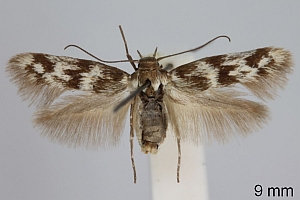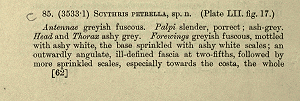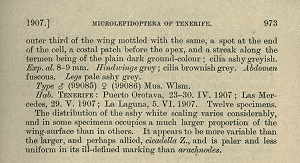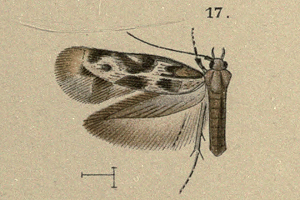

 +1Kontinente:EU
+1Kontinente:EU2. Diagnose
2.1. Geschlecht nicht bestimmt
2.2. Erstbeschreibung
3. Biologie
3.1. Nahrung der Raupe
- [Roccellaceae:] Rocella fusiformis
Bengtsson (1997) schreibt: "Reared from stone lichens Rocella fusiformis L.) (Jäckh, pers. comm.). Adults emerge in April-May." Die Arten der Flechten-Gattung Rocella werden heute systematisch als lichenisierte Schlauch-Pilze (Ascomycota: Arthoniomycetes, Arthoniales) angesehen. Ob sich die Raupe beim Fressen dabei für den Pilz- oder den Algen-Partner (oder beide?) interessiert, ist noch zu klären.
(Autor: Erwin Rennwald)
4. Weitere Informationen
4.1. Etymologie (Namenserklärung)
Synonym S. hierroella: Die vermutete Art wurde auf der Kanaren-Insel El Hierro gefunden.
4.2. Synonyme
- Scythris hierroella Klimesch, 1986 [synonymisiert durch Falck (2023: 655)]
4.3. Taxonomie
Klimesch (1986) berichtet über mehrere noch unbeschriebene Falter-Arten, denen er die Arbeitsnamen "Blastobasis sp. No.1" "Blastobasis sp. No.2" oder "Scythris sp." gab. Bei einer Art verwendete er den Arbeitsnamen "Scythris hierroella (Jäckh in litt.)". Offensichtlich wollte er die Art gar nicht beschreiben: "Jäckh hält die Tiere für eine bona species und hat für sie den Namen hierroella vorgeschlagen. Da jedoch nur weibliche Exemplare vorliegen, wird hier von einer Benennung Abstand genommen. Zur Charakterisierung dieser Form wird nachstehend eine von Abbildungen der Imago und deren Genitale unterstützte Diagnose gebracht". Nach Bengtsson (1997) genügt diese Zusammenstellung aber vollauf einer Artbeschreibung - und Bengtsson (1997) erkennt das Taxon - wenn auch mit Vorbehalt - auch entsprechend als Art und Endemiten von El Hierro an.
Falck (2023: 655) kommt zu einem ganz anderen Schluss, nämlich dass S. hierroella nichts anderes als ein Synonym zu S. petrella ist ! Zu seinen Barcoding-Ergebnissen schrieb er: "DNA barcodes (Figure 54): Sixteen specimens were sequenced, resulting in 658 bp, full length DNA barcode fragments for five specimens, fragments of 648 bp for eight specimens, and fragments of 632 bp, 603 bp and 573 bp for three specimens. The intraspecific divergence is high, and S. petrella is divided into three well-separated sub-groups comprised by nine specimens from Gran Canaria (maximum intraspecific distance 0.16%), four specimens from El Hierro (maximum intraspecific distance 0.52%) and three specimens from Tenerife (maximum intraspecific distance 0.32%). The maximum intraspecific distance between the sub-groups is 1.90% between Gran Canaria and El Hierro, 1.86% between Gran Canaria and Tenerife and 2.70% between El Hierro and Tenerife. The minimum p-distance to nearest neighbour S. aronaella is 1.12%. The barcodes fall within Barcode Index Numbers (BIN) BOLD: AEG7684 (Gran Canaria), AEW1054 (El Hierro) and AEC3981 (Tenerife)." Er bemerkt dazu: "Klimesch (1986) treated the Scythrididae fauna of the Canary Islands and described three new species. He also figured the adults and genitalia of two further species, one without naming it (p. 326) and a second with the preliminary name Scythris sp. (hierroella Jäckh, in litt.). He did not intend to describe S. hierroella, probably because the lack of males. Bengtsson (1997, p.139) raised S. hierroella to species rank based on this description. However, he apparently had his doubts whether it was a distinct species, as he stated, “Males of hierroella caught or reared together with females might definitely solve the taxonomy of these two [S. hierroella and S. petrella, author´s comment] species”. Examination of the male and female genitalia clearly shows that S. hierroella is conspecific with S. petrella. However, there is a divergence in the DNA between the populations from Gran Canaria, El Hierro and Tenerife, see the discussion below."
Die Barcodes von S. petrella entfallen auf 3 verschiedene BINs und der Abstand zur nächsten Art (S. aronaella) ist gering: "DNA barcodes (Figure 54): Sixteen specimens were sequenced, resulting in 658 bp, full length DNA barcode fragments for five specimens, fragments of 648 bp for eight specimens, and fragments of 632 bp, 603 bp and 573 bp for three specimens. The intraspecific divergence is high, and S. petrella is divided into three well-separated sub-groups comprised by nine specimens from Gran Canaria (maximum intraspecific distance 0.16%), four specimens from El Hierro (maximum intraspecific distance 0.52%) and three specimens from Tenerife (maximum intraspecific distance 0.32%). The maximum intraspecific distance between the sub-groups is 1.90% between Gran Canaria and El Hierro, 1.86% between Gran Canaria and Tenerife and 2.70% between El Hierro and Tenerife. The minimum p-distance to nearest neighbour S. aronaella is 1.12%. The barcodes fall within Barcode Index Numbers (BIN) BOLD: AEG7684 (Gran Canaria), AEW1054 (El Hierro) and AEC3981 (Tenerife)."
4.4. Faunistik
Die Art kommt nur auf den Kanarischen Inseln vor. Sie wurde von Teneriffa (Fundorte Puerto Orotava, Las Mercedes und La Laguna) beschrieben - Angaben von anderen Inseln waren mir zunächst nicht bekannt. Falck (2023: 657) konnte dann aber schreiben: "S. petrella is one of the most widely distributed species of the genus in the Canary Islands, and it is known from the islands of El Hierro, Gran Canaria, La Palma (Baez, 2010) and Tenerife, Spain." Die Angaben zu El Hierro betreffen das zuvor als eigene Art beschriebene Taxon S. hierroella.
(Autor: Erwin Rennwald)
4.5. Typenmaterial
Klimesch (1986) berichtet zum Synonym S. hierroensis: "Der vorstehenden Beschreibung lagen 11 ♀ mit der Bezettelung "Ins. Canar., El Hierro, Valverde, 22.4.1956" zugrunde. Von zwei Exemplaren liegen Genitalpräparate vor: GU/ Jäckh 9264 und 9564. Das Material befindet sich in der Coll. Klimesch."
4.6. Literatur
- Bengtsson, B. Å. (1997): Scythrididae. - Microlepidoptera of Europe. Volume 2; – 301 S.; Stenstrup (Apollo Books).
- Falck, P. (2023): New data on the genus Scythris Hübner, [1825] from the Canary Islands (Spain), with description of six new species (Lepidoptera: Scythrididae). — SHILAP Revista de lepidopterología, 51 (204): 653-680. https://doi.org/10.57065/shilap.788. [PDF auf /shilap.org] bzw. [zum PDF-Download auf researchgate.net]
- Beschreibung als Scythris hierroella: Klimesch, J. (1986): Beiträge zur Kenntnis der Microlepidopteren-Fauna des Kanarischen Archipels, 8. Beitrag. Blastobasidae, Scythrididae. — Vieraea 16: 321-340. [Digitalisat auf bibdigital.rjb.csic.es]
- Erstbeschreibung: Walsingham (1908): Microlepidoptera of Tenerife. — The Proceedings of the Zoological Society of London for the Year 1907: 911-1034 + pl. LI-LIII.








